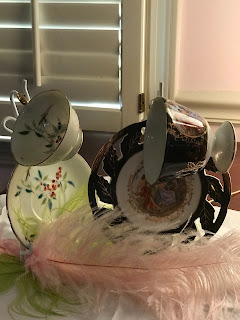All Things Tea
Portugal's Catherine of Braganza
is credited with introducing tea to England after marrying King Charles
II in 1662. That got people curious about this new brew, but it wasn't
until the 1800s, when tea prices dropped dramatically and it became
affordable for everyone, that the culture of tea really took root.
Afternoon tea — the kind of fancy-schmancy affair where we might spot Lady Mary of Downton Abbey — emerged as a social event sometime around the 1830s or 1840s, Richardson writes in A Social History of Tea. And Anna Maria Russell, duchess of Bedford, led the pack.
Back then, lunch for the upper crust was generally a light repast
served at noon, and dinner occurred no earlier than 7:30 p.m. As legend
has it, during one long, food-less afternoon, the duchess felt hunger
pangs and ordered tea and snacks to her bedroom chamber. The
refreshments did the trick, and Russell soon made this tea break a
habit.
The duchess' well-heeled friends began joining her in this post-lunch tea ritual, the story goes, and the practice spread in aristocratic circles. Though some historical references call this ritual "low tea" — because the ladies would sit in low armchairs while sipping — afternoon tea was hardly a humble affair then. Nor is it today.
Here's where you'll find those crustless finger sandwiches and an array of dainty scones, cakes, macaroons and other tempting nibbles. Afternoon tea is generally served around 3 or 4 p.m. these days. Richardson says it's a time to mind your manners. Place your napkin on your lap and stir gently. Splashing tea, clinking cups and spoons and finger licking will make you appear beastly.
And definitely don't devour everything in front of you. Richardson recalls advice that international etiquette expert (and Liv Tyler's grandmother) Dorothea Johnson once gave him: You don't actually want to appear hungry at this meal — propriety calls for restraint.
Afternoon tea — the kind of fancy-schmancy affair where we might spot Lady Mary of Downton Abbey — emerged as a social event sometime around the 1830s or 1840s, Richardson writes in A Social History of Tea. And Anna Maria Russell, duchess of Bedford, led the pack.
Anna Russell, duchess of Bedford. According to the
accepted legend, the duchess — and her hunger pangs — created the
afternoon tea tradition.
The duchess' well-heeled friends began joining her in this post-lunch tea ritual, the story goes, and the practice spread in aristocratic circles. Though some historical references call this ritual "low tea" — because the ladies would sit in low armchairs while sipping — afternoon tea was hardly a humble affair then. Nor is it today.
Here's where you'll find those crustless finger sandwiches and an array of dainty scones, cakes, macaroons and other tempting nibbles. Afternoon tea is generally served around 3 or 4 p.m. these days. Richardson says it's a time to mind your manners. Place your napkin on your lap and stir gently. Splashing tea, clinking cups and spoons and finger licking will make you appear beastly.
And definitely don't devour everything in front of you. Richardson recalls advice that international etiquette expert (and Liv Tyler's grandmother) Dorothea Johnson once gave him: You don't actually want to appear hungry at this meal — propriety calls for restraint.


Comments
Post a Comment